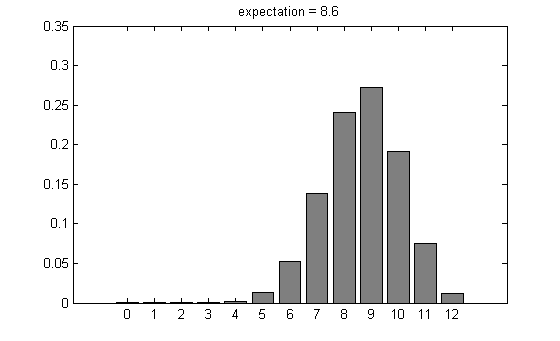College football win totals 2013 - Vegas
http://www.vegasinsider.com/college-football/story.cfm/story/1420974
UM at 9.5, with Vegas favoring the over.
this type of analysis would be great if your sample size was 1000 games, but its not....10 flips of a coin should end up 5 heads and 5 tails...but generally, it doesn't!! (actually, the probability it does is small)...Like I said 12-0
There is a 0% chance that the team wins exactly 8.6 games. And given that we have only one outcome of the season, we don't know which way it will turn out. But two things:
1. If we flip a coin 10 times we are much more likely to get 5 heads than we are to get 10 (and we're more likely to get 5 heads than we are any other number of them)
2. If we flip a coin 10 times, we are just as likely to have more than 5 heads as we are to have fewer, so the expected value is 5. It probably *won't* be 5, but there isn't any better guess.
So, sure, there is a chance of a 12-0 season. But it's a small chance, and if you want to say we're 12-0 is likey (> 50% chance), then that means that you are implicitly saying there's a 95% chance of winning each game. That's a tough sell to me.
but, you forget we are dealing with Humans not coins....once you get on a roll, its not like a coin!
I think
I'm pretty sure it's 8.64.
The problem is defining the decimal probabilities given the amount of uncertainty present. From your decimal table, I'd add an extra tenth to Michigan State, Minnesota, and Iowa. That makes 9 wins. However, I'd put at least an extra tenth of uncertainty on the entire schedule (more if you include potential injuries to Michigan and other teams during the season). Then you have predictions that vary between 6-6 and 12-0 and are all valid.
Given the nature of "take your random-ass guess" threads, it's probably best to let people stick with anecdotes as reason for their predictions.
Yeah there is a lot of uncertainty, but specifying the outcomes using this formulation allows you to look at that too. Here is the probability of winning 0, 1, ..., 12 games assuming the win percentages I gave above:

Who the fuck wants to read shit when they can't get minor details like that-very important in any type of writing-correct?
Over. Easy money.